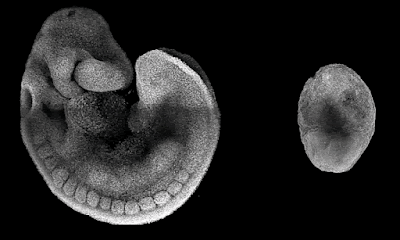Genetic changes fail to explain bacterial antibiotic resistance
https://aac.asm.org/content/64/2/e02225-19
Excerpts:
"Despite extensive research, well-documented biochemical mechanisms and genetic changes fail to fully explain mechanisms underlying antibiotic resistance. Several recent reports suggest a key role for epigenetics in the development of antibiotic resistance in bacteria. The intrinsic heterogeneity as well as transient nature of epigenetic inheritance provides a plausible backdrop for high-paced emergence of drug resistance in bacteria."
"Adaptive resistance. When bacteria are subjected to increasing subinhibitory concentrations of an antibiotic, they develop adaptive resistance to the antibiotic. The characteristic feature of adaptive resistance is the rapidity with which the resistance phenotype emerges and reverts to a susceptible phenotype upon the withdrawal of the antibiotic. The survival rate of bacteria in subinhibitory concentrations of antibiotics cannot be explained by genetic mutations as expected mutation rates that lead to resistance are lower than the observed survival rates. Genetic changes also cannot explain the high reversion rates because for the bacteria to revert to susceptible phenotype, compensatory or back mutations are needed, and these are known to occur at a very low rate. Adaptive resistance is the consequence of the presence of heritable phenotypic variations even in genetically identical bacteria from isogenic populations. Culture-based evolution studies, investigation of genetic knockout and transcriptomes, and modeling-based studies suggest that epigenetic inheritance and stochastic heterogeneity in gene expression patterns are responsible for this phenomenon"
"Epigenetic inheritance is dynamic in nature and thus can explain the transience of adaptive resistance. The resistance which develops when bacteria grow in the presence of nonlethal concentrations of antibiotics could be the consequence of changes in the epigenetic landscape of the bacterial genome. As soon as the antibiotic stress is removed from the environment, the epigenetic changes are no longer sustained on the genome of the subsequent generations, and, thus, they retrogress to a susceptible phenotype."
"Phase variation.Bacteria can survive highly dynamic environments by rapidly modulating the expression of certain genes in a switch-on/switch-off manner, and this reversible switch is called phase variation. There are several ways by which phase variation is brought about, such as DNA inversion, methylation/demethylation of gene promoters or other regulatory sequences, slipped-strand mispairing, homologous recombination, and transposition. Changes in methylation profiles of DNA regulate phase variation in bacteria, but the reverse is true as well, wherein phase variation leads to regulation of the expression of methyltransferases or changes in their target specificities."
"Methylated cytosines act as mutational hot spots.Cytosine undergoes spontaneous deamination to uracil. Since the presence of uracil is atypical in genomic DNA, it gets excised by uracil-DNA glycosylase, initiating the base excision repair pathway. But spontaneous deamination of 5-methylcytosine (m5C) yields thymine, which is not easily recognized by the DNA repair machinery and thus may not get excised or repaired. This results in fixing of the mutation in the genome. The frequency of deamination of m5C is 2 to 4 times higher than that of cytosine. Methylated cytosines are regarded as hot spots for cytosine to thymine mutations in bacteria although very-short-patch (VSP) mismatch repair may reduce the frequency of such mutations."
"A recent report analyzing whole-genome sequences of thousands of bacteria suggests that cytosine methylation may increase the rate of C-to-T transitions by over 50-fold."
"Methylation of cytosine provides a stable framework for the emergence of mutations which can potentially be either deleterious or beneficial for bacteria under antibiotic stress, depending on the site of mutation. Studies investigating the synergy between antibiotic stress-induced error-prone polymerases and C-to-T transitions of methylated cytosines may help us better understand the specific role of methylation-mediated genetic changes in regulating antimicrobial resistance."
"CONCLUSION AND FUTURE PERSPECTIVES
Since well-documented biochemical or genetic changes fail to fully explain mechanisms underlying antibiotic resistance, it is becoming increasingly evident that we need to shift our focus to newer, nonclassical mechanisms such as epigenetic regulation. The biological role of epigenetic modifications in modulating gene expression and other cellular processes is being increasingly recognized. New epigenetic modifications are being discovered in both prokaryotes and eukaryotes, including phosphorothioation in bacterial DNA backbone and acetylation of cytidine in eukaryal mRNA. Since it has been established that modifications in eukaryotic mRNAs can modulate a variety of cellular processes, it may not be too speculative to suggest that such modifications in bacterial transcripts may be linked to critical functions in the bacterial life cycle. Even though m6A modification in bacterial mRNAs has been identified, the epigenetic writers (the enzymes that add the epigenetic tag to the nucleotide), readers, etc., for this modification are yet to be identified. The influence of epigenetics on the heterogeneity among members of isogenic bacterial populations merits detailed studies.
While the literature from the last decade reviewed here unambiguously indicates a role for epigenetics in antibiotic resistance among bacteria, we believe that precise mapping of epigenetic tags on bacterial genomes and their functional analysis will help create a paradigm shift in our understanding of this field. Furthermore, epigenetic modifications on bacterial genomes represent new diagnostic markers as well as novel drug targets."
My comment: Bacterial antibiotic resistance has been an example of evolution for several decades. Modern science has now revealed that it's not about evolution. Epigenetic modifications are mechanism based dynamic changes that often result in errors in DNA. Bacterial antibiotic resistance has nothing to do with evolution. Like any change and adaptation in organisms living in nature, antibiotic resistance is due to epigenetic modifications, in this case in bacterial mRNA (m6a). These changes, however, often result in DNA alterations that are sometimes intentional but mostly are harmful and deleterious because bacterial genome's GC content gradually turns to AT content. Again, mechanisms for devolution are well understood. Evolution never happened. Don't get lost.



